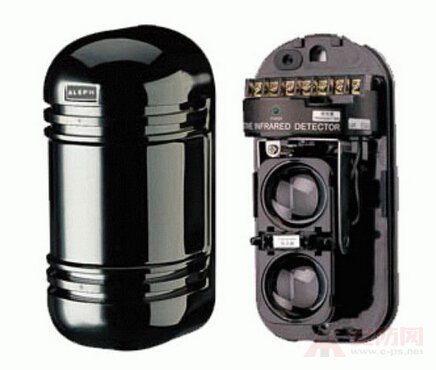[
Huaqiang Security Network News ]
Before introducing the principle of infrared radiation alarm, the concept of infrared radiation detector is introduced. The full name of infrared radiation is called "Photoelectric Beam Detector". Its basic structure includes aiming hole and beam intensity. Indicator lights, spherical lenses, LED indicators, etc. The detection principle is that the infrared light is emitted through the LED infrared light emitting diode, and then the optical mirror is used for focusing processing to transmit the light to a long distance, and is accepted by the light receiver. An alarm is issued when the light is blocked. Infrared is an invisible light that diffuses and projects into a cone beam. Infrared light does not intermittently emit 1000 beams per second, so it is a pulsating infrared beam. As a result, these pairs of shots cannot be transmitted very far (within 600 meters).
A detector that utilizes a beam interception mode intercepts an invisible infrared beam and causes an alarm when someone crosses the surveillance guard zone. Commonly used for outdoor wall alarms, it is always used in pairs: one launch and one receive. The transmitter emits one or more infrared rays that cannot be seen by the human eye, forming a warning line. When an object passes, the light is blocked, the receiver signal changes, and the alarm is amplified. Infrared radiation probes should choose the appropriate response time: too short can cause unnecessary interference, such as flying birds, small animals passing through, etc.; The shortest shading time is usually determined at a speed of 10 m/s. If the person's width is 20 cm, the shortest interruption time is 20 milliseconds. Alarms greater than 20 milliseconds, less than 20 milliseconds without alarm. Infrared radiation detectors are widely used in urban security, community, factories, companies, schools, homes, villas, warehouses, resources, petroleum, chemicals, gas transmission and distribution and many other fields.

Infrared radiation alarm principle - active
The active infrared alarm consists of a transmitter and a receiver. The transmitter comprises a power source, a light source, an optical system and the like. Under the action of the power source, the infrared light emitting diode emits an infrared light beam, and the parallel light is emitted through the optical system. The receiver includes an optical system, an amplifier, an optical sensor, a signal processor and the like, and is responsible for receiving infrared rays emitted by the transmitter, and converting the optical signal into an electrical signal by the photoelectric sensor, and analyzing and processing the signal to the alarm control. Device.
The active infrared alarm uses the transmitter to emit infrared light, and the receiver receives infrared light to work. An infrared warning line is formed between the transmitter and the receiver. Under normal conditions, the transmitter emits infrared rays, and the receiver receives a stable optical signal. Once the alarm is in the area of protection, the infrared beam emitted by the transmitter is blocked, and the receiver receives no longer a stable optical signal, but has a certain degree of change. This change is analyzed and processed. Go to the alarm controller and make an alarm signal.
The active infrared alarm has a far-reaching distance, which is more than ten times the distance of the passive infrared alarm. It has been widely used before.
Infrared radiation alarm principle - passive
The passive infrared alarm is based on the detection of external infrared energy to determine whether someone is moving. The human body temperature is generally around 37 degrees, and it will release infrared light with a wavelength of about 10μm. This infrared energy is different from the surrounding environment. Once the alarm detects infrared rays with a wavelength of about 10μm in its guard area, it will be analyzed and processed. An alarm will be issued.
The process of analysis and treatment is sauce purple, and the infrared rays emitted by the human body are first enhanced by Fresnel filters, and then concentrated on the infrared source (usually using pyroelectric components), and the pyroelectric components are received by the human body. Infrared, the temperature will change, and the charge will be released so that the charge is not conserved. Once this condition is detected in the circuit, it is determined that someone has invaded and generated an alarm signal.



